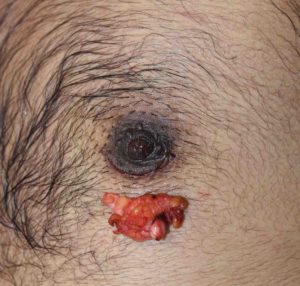Gynecomastia is a well known breast enlargement condition that occurs in men of all ages. Like the broad age range that it affects, gynecomastia also occurs in a wide variety of expressions or degrees of breast enlargement. While often perceived as the appearance of an actual breast mound, most gynecomastias present as much smaller masses.
The smallest presentation of gynecomastia is areolar enlargement or a type 1 gynecomastia. This is also known by how it appears as a puffy nipple. While this can mean a long or protruding nipple, it usually refers to a small growth of breast tissue that sits right under the nipple. It appears as a small hard lump that can be felt under the nipple and causes the nipple-areolar complex to protrude. It may or may not be associated with an elongated nipple as well.

Open excision of small gynecomastias is an art form and the amount of tissue to be removed is an intraoperative judgment. On the one hand over resection is to be avoided so a crater deformity does not result. Conversely under resection, although aesthetically safer, will create less areolar projection but will not make it completely flat. This results in my experience for a 10% to 20% revision rate for this type of male breast reduction surgery to get the most symmetric and complete nipple flattening effect.
Dr. Barry Eppley
Indianapolis, Indiana


